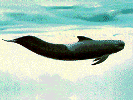
The Heimlich-Borans usually found pilot whales moving through areas with a ater depth of about 1,000 metres. The shales seemed to feed mainly at night, when squid come up from the depths. Typical group size is 10 to 30, although a few pods are as large as 60. Some individuals stay together in core groups of five or six; others move between groups and subgroups. Like orcas, pilot whales live long lives - up to 65 years for females. In all, the researchers have identified 445 individuals off the Canary Islands. About half have been observed two or more times.
The calm water of the study area provided an ideal resting place. During rest periods, the pilot whales travelled short distances and hovered at the surface. From time to time, bottlenose dolphins would arrive, and the whales became more active. then they played, surfing on ocean swells - an amusing sight as the bulbous heads rode on the waves.
Globicephala macrorhynchus
Size: Males 4.5 to 5 m (max 5.5 m), 2,500 kg. Females 3.3 to 3.6 m
(max 5 m), 1,300 kg
Calves at birth: 140 cm
Teeth: 7 to 9 peglike teeth on each side of upper and lower jaws
Food: Squid and various fish
Habitat: Mainly deep offshore waters
Range: Tropical and warm temperate world ocean
Status: Population unknown, but common within its range
